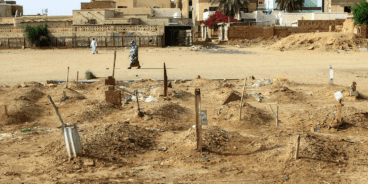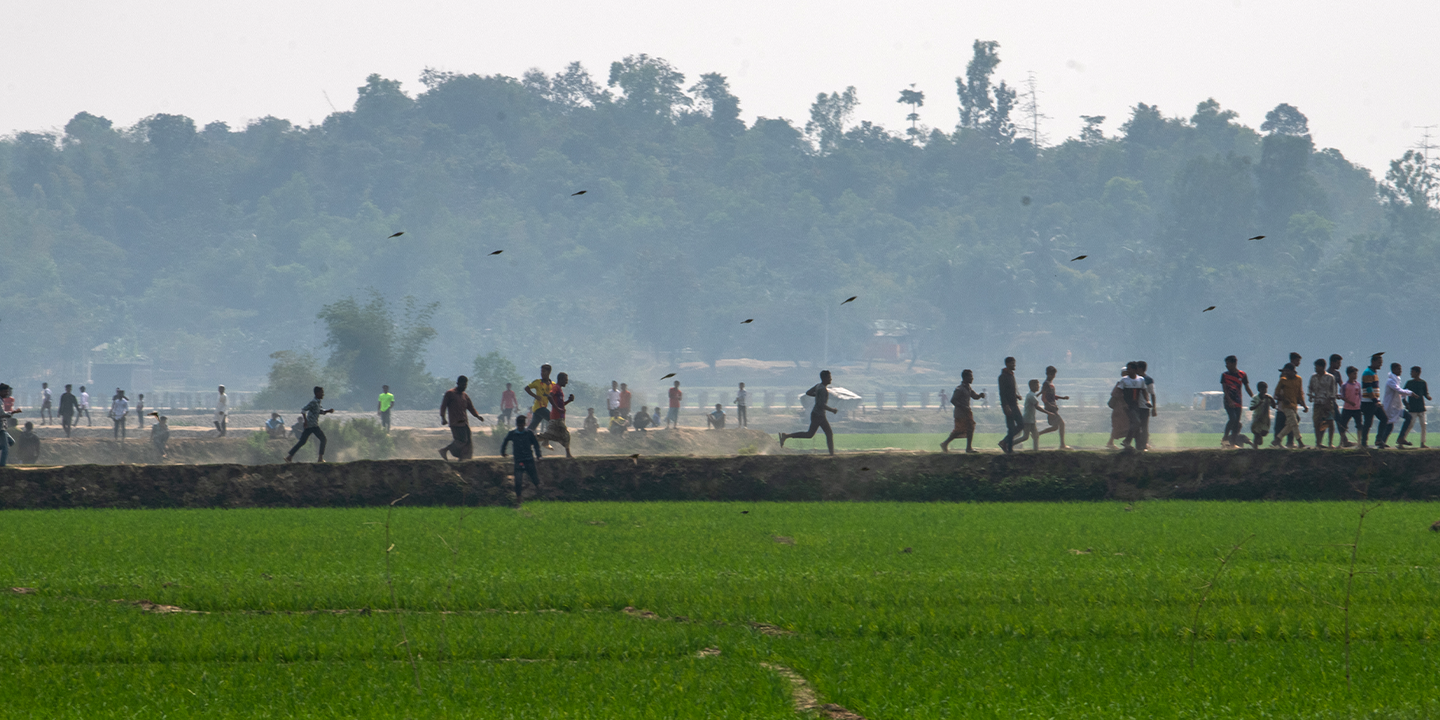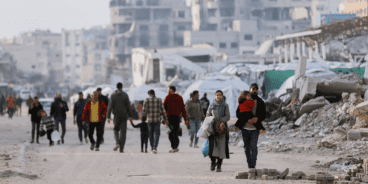

Atrocity Alert No. 407: Myanmar (Burma), Israel and the Occupied Palestinian Territory and World Humanitarian Day
Atrocity Alert is a weekly publication by the Global Centre for the Responsibility to Protect highlighting situations where populations are at risk of, or are enduring, mass atrocity crimes.
ROHINGYA POPULATION ONCE AGAIN ENDURING ATROCITIES IN MYANMAR
This Sunday, 25 August, marks seven years since security forces in Myanmar (Burma) initiated so-called “clearance operations” against the Rohingya population, a distinct Muslim ethnic minority, in Rakhine State. The operations were characterized by brutal violence and grave human rights violations on a mass scale in what a UN Human Rights Council-mandated Fact-Finding Mission on Myanmar concluded to be genocide, war crimes and crimes against humanity. The violence forced over 720,000 Rohingya to flee to Bangladesh where they endure dire conditions in some of the largest refugee camps in the world.
Seven years on, survivors and victims of the Rohingya genocide remaining in Myanmar are facing the threat of atrocity crimes as Rakhine State is besieged by armed conflict again. The Rohingya are increasingly caught in the middle of escalating fighting between the military and Arakan Army (AA), an ethnic Rakhine armed group, which has surged in Rakhine State since November 2023 when an informal ceasefire broke down. In recent months the AA has advanced across Rakhine State, taking control of many predominantly Rohingya areas from the military junta. In response, the military has carried out relentless indiscriminate aerial attacks and blocked Rohingya attempting to escape.
Last month, the UN Special Rapporteur on the situation of human rights in Myanmar, Tom Andrews, warned that the situation “carries echoes of the lead-up to genocidal violence in 2016 and 2017,” while highlighting how the junta has deliberately stoked tensions between the Rakhine and Rohingya communities in Rakhine State. The Rohingya have also been disproportionately targeted in the junta’s forced conscription campaign. Reports have also emerged of atrocities committed by the AA against Rohingya civilians, including mass arrests, forced displacement, looting and the blocking of humanitarian aid. According to the Women’s Peace Network, at least 200 Rohingya – mostly women and children – were killed in drone attacks launched by the AA near the Naf River during the first week of August. Around 20,000 Rohingya were forcibly displaced from downtown Maungdaw prior to this and attempting to escape other attacks by the AA in the area.
Impunity for past atrocity crimes in Myanmar has enabled the ongoing commission of atrocities, while the renewed fighting in Rakhine State compounds existing vulnerabilities and risks for the Rohingya. The Global Centre for the Responsibility to Protect’s Executive Director, Savita Pawnday, said, “For decades, the Rohingya have been systematically persecuted, with little-to-no redress for their generational suffering. On this somber commemoration, the international community must commit to action, including by pursuing justice for both past and ongoing atrocities in Myanmar and cutting off access to the jet fuel, weapons and funds the junta needs to continue to commit atrocities.”
OVER 40,000 KILLED IN GAZA AS INDISCRIMINATE ATTACKS BY ISRAEL CONTINUE
Over 40,000 Palestinians have now been killed in Gaza since 7 October, in addition to over 92,000 injured and tens of thousands missing, likely buried under rubble. On average, this amounts to approximately 130 people killed every day in Gaza over the past 10 months, the majority of whom are women and children. UN High Commissioner for Human Rights Volker Türk grieved this horrific milestone, stating, “This unimaginable situation is overwhelmingly due to recurring failures by the Israeli Defense Forces to comply with the rules of war.”
The Office of the UN High Commissioner for Human Rights has consistently reported that Israel’s repeated use of weapons with wide area and indiscriminate effects in densely populated areas suggests a pattern of willful violation and disregard of the International Humanitarian Law (IHL) principles of distinction, proportionality and precaution. There is overwhelming evidence that these practices have led to disproportionate harm to civilians and damage to civilian infrastructure. The indiscriminate nature of the destruction of homes, displacement shelters, hospitals, schools and places of worship across Gaza has led to countless mass casualty incidents.
Throughout July and August, nearly two dozen Israeli strikes have targeted schools sheltering hundreds of internally displaced families. At least 274 Palestinians, most of whom were internally displaced persons (IDPs), have been killed because of these strikes. The UN Children’s Fund reported that more than half of the schools used as IDP shelters have been directly hit, while a recent assessment by the Education Cluster found that 85 percent of school buildings in Gaza – 477 schools – have been directly hit or damaged since 7 October.
These systematic attacks have been occurring while more than 90 percent of Gaza’s population has been forcibly displaced, most of them multiple times. Throughout August, nine so-called “evacuation orders” have been issued by the Israeli military – including some of the largest in the last 10 months – affecting approximately 213,000 Palestinians. These successive orders have shrunk the size of Israel’s so-called “humanitarian area” in Al Mawasi to about 41 square kilometers – down from 58.9 square kilometers – and dramatically increased overcrowding amid ongoing hostilities, denial of access to necessities and the spread of disease.
Israel as the occupying power is obligated under IHL to provide the population it has forcibly displaced with basic humanitarian needs, including safe shelter. Third party states and the international community must take steps, including through economic and political measures, to ensure Israel complies with all IHL obligations, including the principles of distinction, proportionality and precaution. An immediate ceasefire must be urgently reached, and UN Security Council Resolution 2735 must be implemented without delay.
IMPUNITY MUST END AS ATTACKS ON AID WORKERS REACH UNPRECEDENTED LEVELS
Monday, 19 August, marked World Humanitarian Day, which pays tribute to humanitarian workers who risk their lives while assisting the most vulnerable populations in the world. The theme of this year’s World Humanitarian Day was #ActForHumanity, which aimed to build public support to pressure warring parties and world leaders to better ensure the protection of civilians, including humanitarians, caught in conflict zones.
Despite 75 years of international laws in place to protect civilians and aid workers in conflict zones, state and non-state actors are increasingly and brazenly disregarding their legal obligations. Humanitarians are consequently facing heightened risks of being injured, killed or abducted alongside the civilians they support. Deliberate attacks on humanitarian workers in conflict zones constitute war crimes under International Humanitarian Law (IHL) and are often also linked to attempts to perpetrate other atrocity crimes.
With 280 aid workers killed in deliberate attacks across 33 countries last year, 2023 marked the deadliest year on record for humanitarian workers. Of those killed, 163 were recorded in Gaza between October to December alone, making the Occupied Palestinian Territory the most dangerous place to be an aid worker. This alarming figure is nearly three times the death toll of any other conflict in a single year. Ongoing inter-communal violence in South Sudan resulted in 34 aid worker fatalities and was the second biggest driver of last year’s unprecedented figures.
The UN Office for the Coordination of Humanitarian Affairs warned that 2024 may be even deadlier. According to the Aid Worker Security Database, 187 aid workers have been killed, 68 kidnapped and 101 wounded so far this year. Of the fatalities, 123 have been recorded in Gaza. In Sudan – the next most dangerous situation, with at least 30 aid workers killed, wounded or kidnapped – populations are facing the world’s largest hunger crisis due in part to the consequences of escalating conflict, the denial of humanitarian access and looting of aid.
Joyce Msuya, UN Acting Under-Secretary-General for Humanitarian Affairs and Emergency Relief Coordinator, said, “The normalization of violence against aid workers and the lack of accountability are unacceptable, unconscionable and enormously harmful for aid operations everywhere… We reiterate our demand that people in power act to end violations against civilians and the impunity with which these heinous attacks are committed.”
Vital humanitarian aid can mean the difference between survival and death for millions of people around the world. The international community must ensure that the world’s most vulnerable and those that care from them are protected, as called for in UN Security Council Resolution 2730. All states should uphold their obligations under IHL, as well as use their leverage to ensure that all parties to a conflict, and those supporting them, respect international norms and standards.
Related Content


Atrocity Alert No. 433: Israel and the Occupied Palestinian Territory, Myanmar (Burma) and Mali
